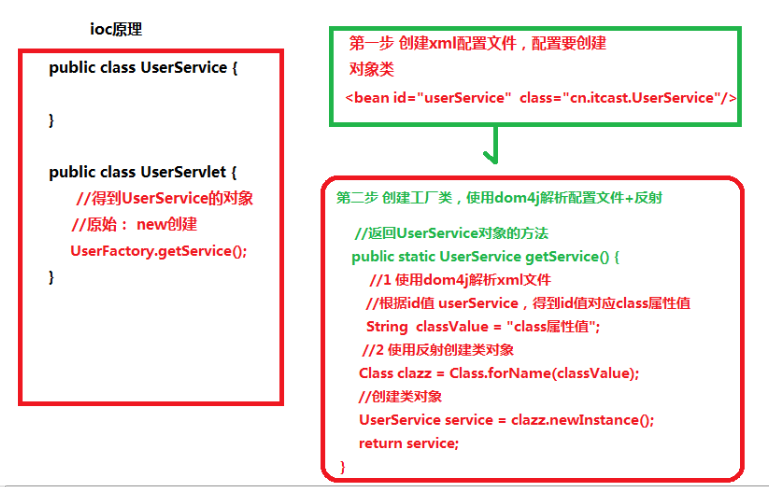spring学习之一概念
概念
1、是开源的轻量级框架
2、是一站式框架,就是说在java ee的三层结构中,每一层它都提供了不同的解决技术
web层:springMVC
servoce层:spring IOC ,控制反转,通过配置的方式来创建bean对象
dao层:spring的jdbcTemplate
3、包含两大核心部分
(1)aop: 面向切面编程,相对于传统的纵向继承方式扩展功能,这种方式不需修改源代码就可以做到扩展,主要用于事务管理
(2) ioc : 控制反转,配置文件来实现创建对象
Ioc实现原理
这个技术的目的很简单,就是从配置文件中读出想要类名字串,利用反射来创建出他的实例,原理如下图

所需jar包 为4个核心的包
--- spring-beans-4.2.4.RELEASE.jar
--- spring-context-4.2.4.RELEASE.jar
--- spring-core-4.2.4.RELEASE.jar
--- spring-expression-4.2.4.RELEASE.jar
ioc的两种创建类的方式
(1)配置文件创建
(2)注解方式
-- 配置文件方式
第一步 创建配置文件,文件名与位置不固定,建议放在src下面,名字与源代码中默认文件名相同applicationContext.xml
第二步 在配置文件中引入schema约束文件
<?xml version="1.0" encoding="UTF-8"?>
<beans xmlns="http://www.springframework.org/schema/beans"
xmlns:mvc="http://www.springframework.org/schema/mvc"
xmlns:tx="http://www.springframework.org/schema/tx"
xmlns:aop="http://www.springframework.org/schema/aop"
xmlns:context="http://www.springframework.org/schema/context"
xmlns:xsi="http://www.w3.org/2001/XMLSchema-instance"
xsi:schemaLocation="
http://www.springframework.org/schema/beans
http://www.springframework.org/schema/beans/spring-beans.xsd
http://www.springframework.org/schema/context
http://www.springframework.org/schema/context/spring-context.xsd
http://www.springframework.org/schema/mvc
http://www.springframework.org/schema/mvc/spring-mvc.xsd
http://www.springframework.org/schema/tx
http://www.springframework.org/schema/tx/spring-tx.xsd
http://www.springframework.org/schema/aop
http://www.springframework.org/schema/aop/spring-aop.xsd "
default-autowire="byName">
</beans>
第三步,配置需要创建的类
<?xml version="1.0" encoding="UTF-8"?>
<beans xmlns="http://www.springframework.org/schema/beans"
xmlns:mvc="http://www.springframework.org/schema/mvc"
xmlns:tx="http://www.springframework.org/schema/tx"
xmlns:aop="http://www.springframework.org/schema/aop"
xmlns:context="http://www.springframework.org/schema/context"
xmlns:xsi="http://www.w3.org/2001/XMLSchema-instance"
xsi:schemaLocation="
http://www.springframework.org/schema/beans
http://www.springframework.org/schema/beans/spring-beans.xsd
http://www.springframework.org/schema/context
http://www.springframework.org/schema/context/spring-context.xsd
http://www.springframework.org/schema/mvc
http://www.springframework.org/schema/mvc/spring-mvc.xsd
http://www.springframework.org/schema/tx
http://www.springframework.org/schema/tx/spring-tx.xsd
http://www.springframework.org/schema/aop
http://www.springframework.org/schema/aop/spring-aop.xsd "
default-autowire="byName">
//ioc配置
<bean id = "user" class="cn.blueto.com.User"></bean>
</beans>
第四步, 引用对象
//加载配置文件
ApplicationContext c = new ClassPathXmlApplicationContext("applicationContext.xml");
//根据配置文件中的对象id取出
User user=c.getBean("user");
在这里值得注意的是,bean标签里有几种属性需要记住
1)id 表示对象的id,被引用时可填Id
2) class 创建对象所在的类的路径
3) name 与id效果一样,为了兼容之前的版本而保留,建议不使用
4)scope 表示范围,取值有
-singleton 默认值就是单例,表示全局只能创建一个实例
-prototype 多例,可创建多个实例
-request 创建对象放在request域里
-session 放在session域里
-gloabSession 放在globalSession里
----属性注入
就是给对象中的属性赋值,先看bean的定义
public class User{
private String name;
//有参数构造方式注入属性
public User(String n){
name = n;
}
//属性
public void setName(String name){
this.name=name;
}
}
配置文件中写法
<bean id="user" class="package.user">
//有参构造方式注入
<constructor-arg name= "name", value="叫啥名好呢"></constructor-arg>
</bean>
setter方式注入
<bean id="user" class="package.user">
<property name= "name", value="叫啥名好呢"></property>
</bean>
注入复杂对象写法
public class User{
private String name;
private Logininfo login;
//复杂对象属性
public void setLogininfo(Logininfo n){
login= n;
}
//属性
public void setName(String name){
this.name=name;
}
}
复杂对象注入的配置文件中写法
<bean id="user" class="package.user">
<property name= "login", ref="login"></property> //ref引用其他beab对象的id
</bean>
<bean id="login" class="package.Logininfo"></bean>
数组等对象注入
public class User{
private String[] arrs;
private List list;
private Map map;
private Properties properties;
//setter方法
。。。
}
<bean id="user" class="package.user">
<property name= "arrs">
<list>
<value>1</value>
<value>2</value>
<value>3</value>
</list>
</property>
<property name= "list">
<list>
<value>a</value>
<value>b</value>
<value>c</value>
</list>
</property>
<property name= "map">
<map>
<entry key ="a1" value="adfdf"></entry>
<entry key ="a2" value="adfdf"></entry>
<entry key ="a3" value="adfdf"></entry>
</map>
</property>
<property name= "properties">
<props>
<prop key ="driverClass">com.xxx.jdbc.Driver</prop>
<entry key ="passwd">123456</entry>
<entry key ="user">addd</entry>
</props>
</property>
</bean>
-- 注解方式创建对象
与上一种方式相比 ,使用注解方式的配置则简单多了
配置文件中写法
<beans xmlns="...">
<!-- 开户注解扫描
到指定包里扫描类,方法及属性上面是否有注解,指定包如果有多个,可用逗号分隔开,如果写成它的父包名字,则指包含父包下所有类
-->
<context:componet-scan base-package="cn.blueto"></context:componet-scan>
<!-- 开户注解扫描
只扫描属性上面是否有注解
-->
<context:annotation-config></context:annotation-config> </bean>
java类中写法
@Component(value="user")
@Scope(value="prototype")
public class User{
private String name;
//有参数构造方式注入属性
public User(String n){
name = n;
}
//属性
public void setName(String name){
this.name=name;
}
}
取得实例
//加载配置文件
ApplicationContext c = new ClassPathXmlApplicationContext("applicationContext.xml");
//根据配置文件中的对象id取出
User user=c.getBean("user");
spring中的创建对象的4个注解
-@Component
-@Controller web层
-@Service 业务层
-@Repository 持久层,数据库操作层
目前四个注解都是一样的效果,只是创建对象而已
spring中的注入属性
-@Autowired 根据类名找到对象的实现类并创建,再注入到属性中
-@Resource 注入指定类的实例到属性中,@Resource(name="beanid")
Spring 加载配置文件原理
ioc原理是在服务加载配置文件后,创建配置文件中的bean对象,也就是执行这段代码:
//加载配置文件
ApplicationContext c = new ClassPathXmlApplicationContext("applicationContext.xml");
//根据配置文件中的对象id取出
//User user=c.getBean("user");
那服务启动后,在什么时候开始加载配置呢?它的加载过程是这样的
--服务器启动时,为每个web项目创建一个servletContext对象,当监听器监听到ServletContext对象创建后,开始加载配置文件,默认文件为applicationContext.xml
--把创建的各个bean对象通过setAttribute方法存到servletContext域里
--取对象时通过getAttribute得到
Spring中已经封装好了监听器并加载配置文件的方法,如果想要在服务启动后自动加载配置文件,只需要在web.xml文件中作如下配置即可
//配置监听器
<listener>
<listener-class>org.springframework.web.context.ContextLoaderListener</listener-class>
</listener> //配置指定加载的配置文件,如果 不配置,则去Src下面找默认的applicationContext.xml
<context-param>
<param-name>contextConfigLocation</param-name>
<param-value>classpath:bean.xml</param-value> //如在src下直接写,如不在则要加包名路径
</context-param>
spring学习之一概念的更多相关文章
- Spring学习之AOP总结帖
AOP(面向方面编程),也可称为面向切面编程,是一种编程范式,提供从另一个角度来考虑程序结构从而完善面向对象编程(OOP). 在进行 OOP 开发时,都是基于对组件(比如类)进行开发,然后对组件进行组 ...
- Spring学习之第一个AOP程序
IOC和AOP是Spring的两大基石,AOP(面向方面编程),也可称为面向切面编程,是一种编程范式,提供从另一个角度来考虑程序结构从而完善面向对象编程(OOP). 在进行 OOP 开发时,都是基于对 ...
- spring技术核心概念纪要
一.背景 springframework 从最初的2.5版本发展至今,期间已经发生了非常多的修正及优化.许多新特性及模块的出现,使得整个框架体系显得越趋庞大,同时也带来了学习及理解上的困难. 本文阐述 ...
- Spring学习(二)——Spring中的AOP的初步理解[转]
[前面的话] Spring对我太重要了,做个关于web相关的项目都要使用Spring,每次去看Spring相关的知识,总是感觉一知半解,没有很好的系统去学习一下,现在抽点时间学习一下Spring. ...
- 我的Spring学习记录(二)
本篇就简单的说一下Bean的装配和AOP 本篇的项目是在上一篇我的Spring学习记录(一) 中项目的基础上进行开发的 1. 使用setter方法和构造方法装配Bean 1.1 前期准备 使用sett ...
- 【转】Spring学习---Bean配置的三种方式(XML、注解、Java类)介绍与对比
[原文]https://www.toutiao.com/i6594205115605844493/ Spring学习Bean配置的三种方式(XML.注解.Java类)介绍与对比 本文将详细介绍Spri ...
- 不错的Spring学习笔记(转)
Spring学习笔记(1)----简单的实例 --------------------------------- 首先需要准备Spring包,可从官方网站上下载. 下载解压后,必须的两个包是s ...
- Spring学习13-中IOC(工厂模式)和AOP(代理模式)的详细解释
我们是在使用Spring框架的过程中,其实就是为了使用IOC,依赖注入,和AOP,面向切面编程,这两个是Spring的灵魂. 主要用到的设计模式有工厂模式和代理模式. IOC是工厂模式参考:设计模式- ...
- spring学习 8-面试(事务,解决线程安全)
1.介绍一下Spring的事物管理 参考:Spring 学习7 -事务 2.Spring如何处理线程并发问题 Spring使用ThreadLocal解决线程安全问题 参考:Spring学习11- ...
随机推荐
- AJAX实现无刷新登录
最近学习了如何实现无刷新登录,大体的效果如下(界面比较丑,请自行忽略....): 点击登录按钮时弹出登录窗口,输入正确的用户名密码后点击登录则登录窗口关闭,状态改为当前用户名. 第一步: 首先弹出窗口 ...
- bzoj1026windy数
题目链接:http://www.lydsy.com/JudgeOnline/problem.php?id=1026 Description windy定义了一种windy数.不含前导零且相邻两个数字之 ...
- 毕业设计预习:maxplus2入门教程
maxplus2入门教程 一.安装配置(maxplus2.zip) 下载安装完成后,运行maxstart.exe,显示如下错误提示: 为节省配置工作,在E:盘下新建maxplus2文件夹,仅将所需附加 ...
- MySQL 第八篇:ORM框架SQLAlchemy
一 介绍 SQLAlchemy是Python编程语言下的一款ORM框架,该框架建立在数据库API之上,使用关系对象映射进行数据库操作,简言之便是:将对象转换成SQL,然后使用数据API执行SQL并获取 ...
- go语言操作mongodb
Install the MongoDB Go Driver The MongoDB Go Driver is made up of several packages. If you are just ...
- Java-异常机制详解以及开发时异常设计的原则要求
Java-异常机制详解以及开发时异常设计的原则要求 http://blog.csdn.net/Jack__Frost/article/details/52760930?locationNum=6
- TCP: time wait bucket table overflow解决方法
/var/log/messages 中出现大量的 TCP: time wait bucket table overflow 引起该现象的原因是服务器tcp的连接数太多,超出了内和定义的最大数 临时改变 ...
- C#线程篇---线程池如何管理线程(6完结篇)
C#线程基础在前几篇博文中都介绍了,现在最后来挖掘一下线程池的管理机制,也算为这个线程基础做个完结. 我们现在都知道了,线程池线程分为工作者线程和I/O线程,他们是怎么管理的? 对于Microsoft ...
- mysql 优化之查询缓存(mysql8已经废弃这个功能)
对于缓存,一般人想到的是 redis.memcache 这些内存型的缓存. 但是实际上 mysql 也提供了缓存,mysql 里面的缓存是查询缓存,可以把我们查询过的语句缓存下来,下一次查询的时候有可 ...
- python基础之字符串格式化
python中字符串格式化有两种,一种是%,另一种是str中的format()功能. % 列举格式符 %s 字符串 %c 单个字符 %b 二进制整数 %d 十进制整数 %i ...
